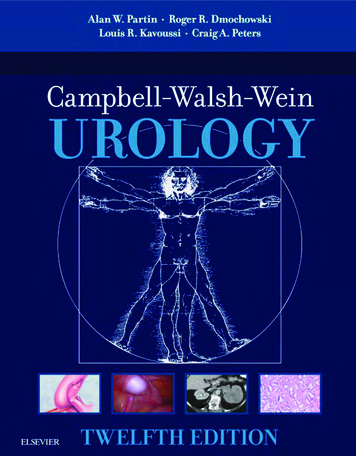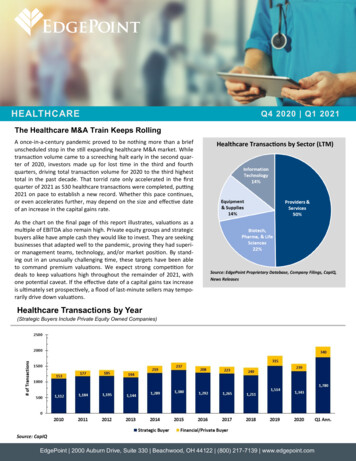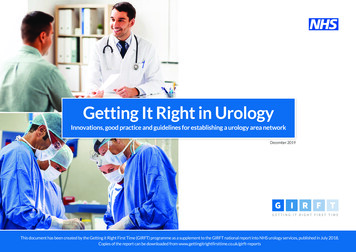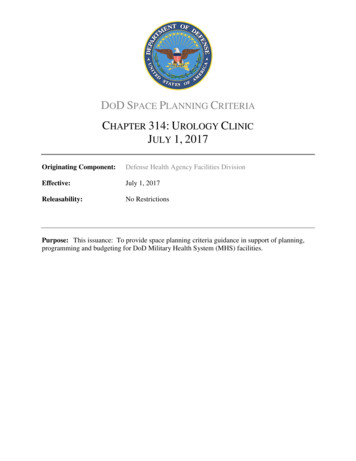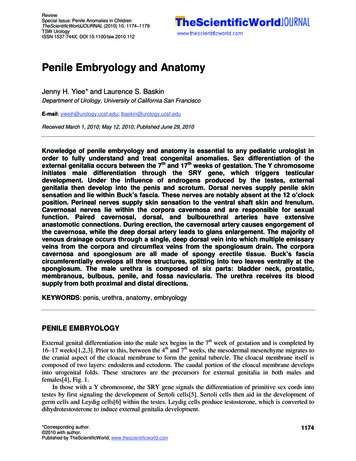
Transcription
Supplemental Guide for UrologySupplemental Guide:UrologyApril 20201
Supplemental Guide for UrologyTABLE OF CONTENTSIntroduction . 3Patient Care . 4Patient Evaluation . 4Peri-Procedural Care. 6Endoscopic Procedures . 8Open Procedures . 9Minimally Invasive Procedures (Laparoscopic and Robotic) . 10Office-Based Procedures . 12Medical Knowledge . 14Clinical Medical Knowledge. 14Clinical Reasoning . 16Systems-Based Practice . 17Patient Safety and Quality Improvement (QI) . 17System Navigation for Patient-Centered Care . 19Physician Role in Health Care Systems . 21Practice-Based Learning and Improvement. 23Evidence-Based and Informed Practice . 23Reflective Practice and Commitment to Personal Growth . 24Professionalism . 26Professional Behavior and Ethical Principles . 26Administrative Tasks . 28Well-Being . 29Interpersonal and Communication Skills . 30Patient- and Family-Centered Communication . 30Patient Counseling and Shared Decision Making . 32Interprofessional and Team Communication . 34Communication within Health Care Systems . 36Mapping of 1.0 to 2.0 . 372
Supplemental Guide for UrologyMilestones Supplemental GuideThis document provides additional guidance and examples for the Urology Milestones. This is not designed to indicate any specificrequirements for each level, but to provide insight into the thinking of the Milestone Work Group.Included in this document is the intent of each Milestone and examples of what a Clinical Competency Committee (CCC) mightexpect to be observed/assessed at each level. Also included are suggested assessment models and tools for each subcompetency,references, and other useful information.Review this guide with the CCC and faculty members. As the program develops a shared mental model of the Milestones, considercreating an individualized guide (Supplemental Guide Template available) with institution/program-specific examples, assessmenttools used by the program, and curricular components.Additional tools and references, including the Milestones Guidebook, Clinical Competency Committee Guidebook, and MilestonesGuidebook for Residents and Fellows, are available on the Resources page of the Milestones section of the ACGME website.3
Supplemental Guide for UrologyPatient Care 1: Patient EvaluationOverall Intent: To efficiently obtain and synthesize the history, physical exam, and collateral patient data to develop an appropriatemanagement planMilestonesExamplesAll examples relate to a patient with hematuria and its potential causesLevel 1 Obtains history and physical exam to Obtains a history and physical exam for a patient with hematuria; identifies risk factorsform a patient assessmentand determines if work-up is indicated Confirms dipstick hematuria with a microscopic urinalysis Differentiates between gross hematuria and microscopic hematuriaLevel 2 Evaluates patients; orders and Recognizes contaminated urine specimens and orders a catheterized specimeninterprets diagnostic testing Orders appropriate radiographic imaging and endoscopic evaluation Interprets computerized tomography (CT) scans and ultrasounds Identifies indications for cytologyLevel 3 Develops a plan to manage patients Develops a plan for pertinent findings and results of initial work-up of a small bladderwith straightforward conditionstumor Develops a plan for a renal pelvic stone Identifies indications for continuous bladder irrigation As the condition worsens, recognizes the need to escalate careLevel 4 Develops a plan to manage patients Manages refractory hemorrhagic cystitis patientswith complex conditions and adapts plan for Manages unstable hemorrhage after partial nephrectomychanging clinical situationLevel 5 Develops a clinical pathway for the Develops an institutional clinical algorithm for managing patients with radiation cystitismanagement of patients with complex Refers and counsels patients with metastatic bladder cancer for appropriate clinical trialconditions or identifies clinical trials for patientsAssessment Models or Tools Clinical case discussion assessment Direct observation End-of-rotation evaluation Medical record (chart) audit Multisource feedback Observed structured clinical examination SimulationCurriculum Mapping Notes or Resources AUA University. Guidelines. https://www.auanet.org/guidelines. 2019. AUA University. AUA Urology Core Curriculum. https://auau.auanet.org/core. 2019. AUA University. Update series itle Update%20Series%20Volume&order title&sort desc. 2019.4
Supplemental Guide for Urology Wein AJ, Kavoussi LR, Partin AW, Peters CA. Campbell-Walsh Urology. 11th ed.Philadelphia, PA: Elsevier; 2015. ISBN: 978-1455775675.5
Supplemental Guide for UrologyPatient Care 2: Peri-Procedural CareOverall Intent: To safely provide comprehensive pre-operative, intra-operative, and post-operative management of patients, includingphysiologic alterations and complicationsMilestonesExamplesLevel 1 Identifies alterations in normal Identifies post-operative hypotension, fever, or tachycardiaphysiology Selects appropriate pre-operative antibiotics Appropriately selects prophylaxis for venous thromboembolismLevel 2 Accurately and reliably gathers and Orders appropriate testing for chest painreports clinical information pertaining to common Orders appropriate work-up for feverperi-procedural alterations and complications Performs appropriate workup of altered mental statusLevel 3 Independently identifies and prioritizes Manages oliguria after sacrocolpopexy or slingtasks necessary for management of common Manages post-operative anemiaperi-procedural alterations and complications Manages hypotension in a postoperative partial nephrectomy Manages continuous bladder irrigationLevel 4 Independently identifies and prioritizes Manages infected lymphocele following pelvic lymphadenectomytasks necessary for management of complex Manages chylous ascites after xanthogranulomatous pyelonephritis nephrectomyand/or less common peri-procedural alterations Manages pheochromocytoma using pharmacologyand complications Recognizes the need for and initiates early parenteral nutrition supportLevel 5 Proactively recognizes potential risk Manages septic shock in immunosuppressed coagulopathic patientfactors for complications, and implements Manages multidisciplinary care for a patient with pelvic fracture and posterior urethralmeasures to prevent or mitigate them, applyingdisruptioneffective team management skills to managemultiple scenarios simultaneouslyAssessment Models or Tools Clinical case discussion assessment Direct observation End-of-rotation evaluation Medical record (chart) audit Multisource feedback Observed structured clinical examination SimulationCurriculum Mapping Notes or Resources add one for prioritization AUA University. AUA Urology Core Curriculum. https://auau.auanet.org/core. 2019. AUA University. Update series itle Update%20Series%20Volume&order title&sort desc. 2019. Wein AJ, Kavoussi LR, Partin AW, Peters CA. Campbell-Walsh Urology. 11th ed.Philadelphia, PA: Elsevier; 2015. ISBN: 978-1455775675.6
Supplemental Guide for Urology Venous thromboembolism (VTE) and Chest Guidelines AUA University. Guidelines. https://www.auanet.org/guidelines. 2019. Taneja S, Shah O. Complications of Urologic Surgery. 5th ed. Philadelphia, PA: Elsevier;2017. ISBN:9780323392426.7
Supplemental Guide for UrologyPatient Care 3: Endoscopic ProceduresOverall Intent: To perform endoscopic procedures safely and efficientlyMilestonesLevel 1 Prepares patient and equipment forendoscopic procedures (e.g., lithotomypositioning, assemble endoscope)Level 2 Independently performs bedsideendoscopic procedures (e.g., cystoscopy withcatheter placement over a wire)Level 3 Independently performs simpleendoscopic procedures (e.g., simpletransurethral resection of a bladder tumor(TURBT), simple ureteroscopy (URS), smalltransurethral resection of the prostate (TURP))Level 4 Independently performs complexendoscopic procedures (e.g., percutaneousnephrolithotomy (PCNL), complex URS,complex TURBT, large TURP)Level 5 Independently performs complexendoscopic procedures in altered anatomy (e.g.,horseshoe kidney, urinary diversion, spinalmalformation)Assessment Models or ToolsCurriculum MappingNotes or ResourcesExamples Correctly assembles endoscopic equipment Appropriately positions patient with pressure points padded and limbs situatedergonomically Visualizes entire surface of bladder during cystoscopy Anticipates need for additional supplies for catheter placement over wire Anticipates additional equipment needed for procedure Judiciously uses disposable equipment Safely performs:o transurethral resection of a bladder tumor (TURBT) of a 3 cm posterior wall lesiono transurethral resection of the prostate (TURP) for 40 gm prostateo ureteropyeloscopy with laser lithotripsy Appropriately manages intraoperative endoscopic complications Safely performs:o Percutaneous nephrolithotomy (PCNL)o TURBT of a 5cm bladder tumor at the lateral bladder wall or domeo TURP for 80 gm prostate Manages a severely encrusted ureteral stent Obtains percutaneous renal access Clinical case discussion assessment Crowdsourcing assessment of surgical skills Direct observation End-of-rotation evaluation Medical record (chart) audit Multisource feedback Simulation Surgical skills assessment tool American Urological Association (AUA) University. AUA Urology Core Curriculum.https://auau.auanet.org/core. 2019. AUA University. Surgical Video Library. https://auau.auanet.org/node/25250. 2019.8
Supplemental Guide for Urology Smith D, Preminger G, Badlani GH, Kavoussi LR. Smith’s Textbook of Endourology. 4thed. Hoboken, NJ: Wiley Blackwell; 2019. ISBN:978-1-119-24516-2.9
Supplemental Guide for UrologyPatient Care 4: Open ProceduresOverall Intent: To competently and independently perform simple and complex open urologic proceduresMilestonesLevel 1 Demonstrates basic skills (e.g.,positioning, knot tying, suturing)Level 2 Independently performs bedside openprocedures (e.g., incision and drainage,priapism aspiration and irrigation, circumcision,removal of genital wart)Level 3 Independently performs simple openprocedures (e.g., scrotal procedures,vasectomy, cystorrhaphy, mid-urethral sling)Examples Positions patient for common surgery Performs closure of skin incision Manages wound vacuum dressing changes Ties square knots using one or both hands Performs incision and drainage of a scrotal abscess Performs dorsal slit for refractory paraphimosis Performs complex dressing changes with debridement on a Fournier’s gangrene patient Performs hydrocelectomy, orchiopexy, orchiectomy, synthetic mid-urethral sling Repairs an iatrogenic bladder injury in a non-radiated field Performs primary artificial urinary phincter/inflatable penile prosthesis placement in a nonradiated patientLevel 4 Independently performs complex open Revises/replaces an infected three-piece inflatable penile prosthesisprocedures (e.g., partial nephrectomy, prosthetic Performs extravesical ureteral reimplantreplacement, cystectomy and ileal conduit, Performs simple prostatectomyureteral reconstruction) Performs excision and repair of urethral diverticulumLevel 5 Independently performs uncommon Performs salvage cystectomy or prostatectomycomplex open procedures (e.g., retroperitoneal Performs a nephrectomy for xanthogranulomatous pyelonephritislymph node dissection (RPLND), nephrectomy Performs gender affirming surgerywith caval thrombus, reconstructive genital Performs microscopic vasoepididymostomysurgery)Assessment Models or Tools Clinical case discussion assessment Crowdsourcing assessment of surgical skills Direct observation End-of-rotation evaluation Medical record (chart) audit Multisource feedback Objective Structured Assessment of Technical Skills Simulation Surgical skills assessment toolCurriculum Mapping Notes or Resources Smith J, Howards S, Preminger G, Dmochowski R. Hinman's Atlas of Urologic Surgery.4th ed. Philadelphia, PA: Elseview; 2018. ISBN:978-0-12-801648-0.10
Supplemental Guide for Urology AUA University. Surgical Video Library. https://auau.auanet.org/node/25250. 2019.11
Supplemental Guide for UrologyPatient Care 5: Minimally Invasive Procedures (Laparoscopic and Robotic)Overall Intent: To competently navigate minimally invasive techniques to provide safe and effective patient careMilestonesLevel 1 Demonstrates basic skills (e.g.,positioning, draping, docking and undocking)Level 2 Assists during minimally invasiveprocedures (e.g., port placement, bedsideassistant)Level 3 Independently performs simple portionsof the procedure (e.g., bladder takedown, colonreflection, pelvic lymph node dissection)Level 4 Independently performs critical(complex) portions of the procedure (e.g., hilardissection, renorrhaphy, anastomosis)Level 5 Independently performs advancedminimally invasive procedures (e.g., cystectomy,complex partial nephrectomy, complexreconstruction)Assessment Models or ToolsCurriculum MappingNotes or ResourcesExamples Properly drapes and preps patient to maintain sterile field Properly adjusts robotic console and table height for optimized ergonomics Holds camera steadily during laparoscopic procedure Efficiently exchanges surgical tools during laparoscopic and robotic procedures Maintains correct depth perception and force of tissue manipulation Independently reflects colon during minimally invasive nephrectomy Independently exposes ureteropelvic junction for pyeloplasty Exposes correct anatomy for sacral colpopexy Independently completes vesicourethral anastomosis in robotic-assisted laparoscopicprostatectomy Independently completes nerve-sparing portion of robotic-assisted laparoscopicprostatectomy Independently completes robotic partial nephrectomy for exophytic tumor Manages an intraoperative rectal injury during prostatectomy Completes intracorporeal urinary diversion following radical cystectomy Completes partial nephrectomy for hilar tumor Clinical case assessment Crowdsourcing assessment of surgical skills Direct observation End-of-rotation evaluation Global Evaluative Assessment of Robotic Skills Multisource feedback Simulation Surgical skills assessment tool Virtual skills simulator Virtual skills simulator Fundamentals of Laparoscopic Surgery. https://www.flsprogram.org/. 2019.12
Supplemental Guide for UrologyPatient Care 6: Office-Based ProceduresOverall Intent: To proficiently perform all manner of office procedures encountered in independent practiceMilestonesLevel 1 Demonstrates basic skills in officeprocedures (e.g., Foley catheter placement,drain removal)Level 2 Performs simple office-basedprocedures, with direct supervision (e.g.,prostate biopsy, urodynamics interpretation,vasectomy, urethral stricture dilation)Level 3 Independently performs simple officebased procedures, including percutaneoussuprapubic tube placemenLevel 4 Independently performs complex officebased procedures (e.g., renal ultrasound,bladder biopsy, Botox injection)Level 5 Independently performs advancedoffice-based procedures (e.g., stage 1neuromodulation, minimally invasive benignprostatic hyperplasia (BPH) procedure, penileultrasound)Assessment Models or ToolsCurriculum MappingNotes or ResourcesExamples Places Foley catheter Removes staples Changes suprapubic tube Performs bladder irrigation Performs flexible diagnostic cystoscopy Performs trans rectal ultrasound with prostate biopsy Performs routine penile or inguinal cord block Performs intra-cavernosal injections Performs flexible diagnostic cystoscopy with urethral dilation Performs urodynamics with interpretation Places suprapubic tube Performs a bladder Botox injection Performs cystoscopy and biopsy/fulguration Performs penile plaque injection Performs targeted prostate biopsy Performs testicular sperm aspiration Performs ultrasound-guided renal biopsy Performs minimally invasive benign prostatic hyperplasia procedure Direct observation End-of-rotation evaluation Multisource feedback Simulation Urology boot camp or dry lab sessions AUA Hands-On Courses. http://www.aua2019.org/register/hands-on-courses. 2019. AUA University – Consults and Emergencies, Ultrasound, Foley and Suprapubic Tubeshttps://auau.auanet.org/ 2019.13
Supplemental Guide for UrologyMedical Knowledge 1: Clinical Medical KnowledgeOverall Intent: To demonstrate comprehensive knowledge, including guidelines, of the full spectrum of urologic diseases, treatments, andpopulationsMilestonesExamplesLevel 1 Demonstrates knowledge of anatomy Describes the layers of the abdominal walland physiology as it pertains to surgical Demonstrates knowledge of male urethral segmentsconditions Demonstrates knowledge of anatomy of the inguinal canal Demonstrates knowledge of prostate anatomyLevel 2 Demonstrates knowledge of Describes pathophysiology of hyperoxaluria in a patient with inflammatory bowel diseasepathophysiology and treatments of simple Describes the pathophysiology and treatment of stress urinary incontinenceurologic conditions Describes the treatment of undescended testicleLevel 3 Demonstrates knowledge of Describes treatment of a pediatric patient with cystinuriapathophysiology and treatments of complex Describes management of a patient with stage IB testicular germ cell tumor in a nonurologic conditions considering patient factorscompliant patient or with limited access to care(e.g., comorbidity, social context) Distinguishes between obstructive and non-obstructive azoospermiaLevel 4 Demonstrates comprehensive Recognizes the need for upper tract surveillance in patients with Lynch syndromeknowledge, including guidelines, of the full Discusses the role of biomarkers in prostate cancerspectrum of urologic diseases, treatments, and Describes peri-operative management of a patient with pheochromocytomapopulationsLevel 5 Creates a curriculum for clinical medical Develops a regular didactic review for other members of the health care teamknowledgeAssessment Models or Tools AUA Self-assessment study program Case-based discussion assessment Direct observation End-of-rotation evaluations In-service exam Mock oral examination Multisource feedbackCurriculum Mapping Notes or Resources AUA. Guidelines. https://www.auanet.org/guidelines. 2019. AUA University. AUA Urology Core Curriculum. https://auau.auanet.org/core. 2019. Wein AJ, Kavoussi LR, Partin AW, Peters CA. Campbell-Walsh Urology. 11th ed.Philadelphia, PA: Elsevier; 2015. ISBN: 978-1455775675. Fisher JD, PachaT, Santucci RA. Urology In-Service and Board Review - The Essentialand Concise Study Guide. Corpus Christi, TX: BMED Press LLC; 2013. ISBN: 9780982749838. AUA. AUA Inside Tract Podcast. https://www.auanet.org/podcast. 2019.14
Supplemental Guide for Urology Pocket Guide to Urology. http://www.pocketguidetourology.com/. 2019.15
Supplemental Guide for UrologyMedical Knowledge 2: Clinical ReasoningOverall Intent: To use sound reasoning and data synthesis skills for safe clinical decision makingMilestonesLevel 1 Integrates patient-specific information togenerate an appropriate working diagnosisLevel 2 Provides a prioritized differentialdiagnosis using supporting rationaleLevel 3 Independently synthesizes clinicalinformation to inform diagnosis and therapy insimple cases and adapts based on a patient’sclinical course and additional dataLevel 4 Independently synthesizes clinicalinformation to inform diagnosis and therapy incomplex cases, recognizing sources of errorLevel 5 Teaches others to recognize sources ofdiagnostic errorAssessment Models or ToolsCurriculum MappingNotes or ResourcesExamplesAll examples relate to prostate cancer screening Identifies patients for prostate cancer screening while considering patient’s risk factorsand preference Develops a list of potential causes for elevated prostate-specific antigen levels Explains indications for ordering a repeat prostate-specific antigen level Uses risk stratification tools to determine need for additional diagnostic testing forelevated prostate-specific antigen levels Uses predictive prostate cancer nomograms to counsel patients Explains the indications for systematic versus targeted biopsy for elevated prostatespecific antigen levels Appropriately manages patients with persistently elevated prostate-specific antigen levelsafter previous negative prostate biopsy Incorporates emerging evidence to revise the clinical plan Reviews institutional prostate cancer screening patterns to assess for bias and deliversfeedback to providers AUA In-service examination Clinical case discussion assessment Direct observation End-of-rotation evaluation Medical record (chart) audit Mock oral examination Multisource feedback Observed structured clinical examination Society to Improve Diagnosis in Medicine. Inter-Professional Consensus Curriculum onDiagnosis and Diagnostic Error.https://www.improvediagnosis.org/?s competency summary list. 2019. Society to Improve Diagnosis in Medicine. Driver t/uploads/2018/10/Driver Diagram July 31 - M.pdf. 2019. Society to Improve Diagnosis in Medicine. Assessment of Reasoning Tool.https://www.improvediagnosis.org/art/. 2019. CancerNomograms. http://labs.fccc.edu/nomograms/. 2019.16
Supplemental Guide for UrologySystems-Based Practice 1: Patient Safety and Quality Improvement (QI)Overall Intent: To engage in the analysis and management of patient safety events, including relevant communication with patients,families, and health care professionals; to conduct a QI projectMilestonesExamplesLevel 1 Demonstrates knowledge of common Lists patient misidentification or medication errors as common patient safety eventspatient safety events and institutional reporting Describes how to report errors in your local environmentsystemDemonstrates knowledge of basic qualityimprovement methodologies and metricsLevel 2 Identifies and reports patient safetyevents Describes importance of surgical checklist, including time-outDescribes local quality improvement initiatives(e.g., multimodal analgesics, antibioticstewardship, smoking cessation, hospitalacquired infection)Level 3 Participates in analysis of patient safetyevents (simulated or actual) Summarizes protocols resulting in decreased spread of hospital acquired C. difficileParticipates in local quality improvementinitiativesLevel 4 Offers strategies (simulated or actual) toprevent patient safety events Participates in project identifying root cause of retained ureteral stentDemonstrates the skills required to identify,develop, implement, and analyze a qualityimprovement projectLevel 5 Actively engages and leads teams andprocesses to prevent patient safety events Designs a local QI project to increase patient compliance or provide additional educationalmaterials for patientsCreates, implements, and assesses qualityimprovement initiatives at the institutional orcommunity levelAssessment Models or Tools Designs a regional or national QI project to appropriately utilize imaging in themanagement of prostate cancer Identifies lack of hand sanitizer dispenser at each clinical exam room may lead toincreased infection rates Reports breakdowns of sterile processing that could harm patients Presents patient safety event at morbidity and mortality conference Collaborates with a multidisciplinary team to analyze and decrease risk of catheterassociated urinary tract infection or surgical site infections Assumes a leadership role at the departmental or institutional level to improve patientsafety Conducts a simulation for disclosing patient safety events Direct observation17
Supplemental Guide for UrologyCurriculum MappingNotes or Resources E-module multiple choice tests Local patient safety event reporting Medical record (chart) audit Multisource feedback Resident portfolio Simulation Institute of Healthcare Improvement. http://www.ihi.org/Pages/default.aspx. 2019 AUA. Quality Improvement Summit. ar/quality-improvement-summit. 2019. AUA University. AUA Urology Core Curriculum. https://auau.auanet.org/core. 2019.18
Supplemental Guide for UrologySystems-Based Practice 2: System Navigation for Patient-Centered CareOverall Intent: To effectively navigate the health care system, including the interdisciplinary team and other care providers; to adapt care toa specific patient population to ensure high-quality patient outcomesMilestonesExamplesLevel 1 Demonstrates knowledge of care For a patient with advanced prostate cancer, identifies that care is delivered through multicoordination and community health needsdisciplinary team members Identifies that patients with different backgrounds may have different needsPerforms safe and effective transitions ofcare/hand-offs in routine clinical situationsLevel 2 Coordinates multidisciplinary care ofpatients in routine clinical situations, consideringinequities and disparities for their localpopulation (e.g., cultural barriers) Lists the essential components of sign-out, care transition and hand-offsPerforms safe and effective transitions ofcare/hand-offs in complex clinical situationsLevel 3 Coordinates multidisciplinary care ofpatients in complex clinical situation andincorporates local resources into the plan (e.g.,home parenteral nutrition, postoperativeintravenous feeding, intensive care unit) Routinely uses sign-out effectively for a stable patientSupervises safe and effective transitions ofcare/hand-offs of junior residentsLevel 4 Leads care coordination of patients withbarriers or other disparities in care (e.g., traumapatient with no access to care) Supervises safe hand-offs when transferring a patient to the intensive care unit (ICU)Resolves conflicts in transitions of care betweenteamsLevel 5 Designs innovative care coordinationstrategies for populations with health careinequities Effectively manages times when volume of work outpaces available resourcesLeads in the design and implementation ofimprovements to transitions of care Develops a protocol to improve transitions to long-term care facilities Appropriately coordinates translation services for patients and provides patient materialsthat are sensitive to patient background Coordinates a plan with the social worker to initiate home health care for patients withcomplicated wound care Works with patients to provide affordable medications and treatments Leads coordination of care for patients without insurance or means to access care Develops a telemedicine pilot to improve access to care19
Supplemental Guide for UrologyAssessment Models or ToolsCurriculum MappingNotes or Resources Direct observation Medical record (chart) audit Multisource feedback Observed structured clinical examination Review of sign-out tools, use and review of checklists Rotation evaluation CDC. Population Health Training in Place Program atis.html. 2019.
This document provides additional guidance and examples for the Urology Milestones. This is not designed to indicate any specific . Smith D, Preminger G, Badlani GH, Kavoussi LR. Smith's Textbook of Endourology. 4th ed. Hoboken, NJ: Wiley Blackwell; 2019. ISBN: 978-1-119-24516-2. Supplemental Guide for Urology : Patient Care : 10 :
